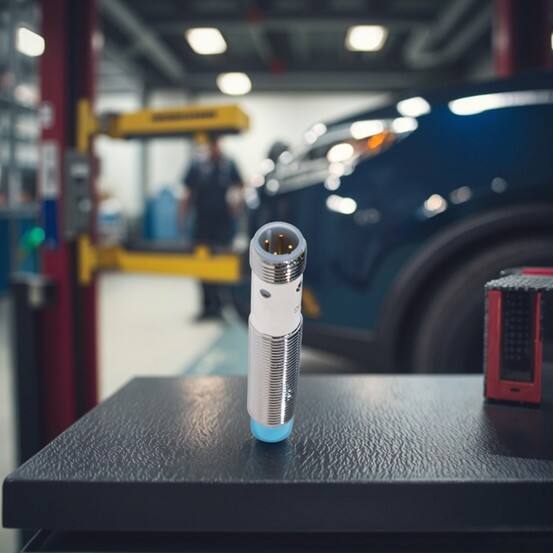Κατανόηση της Δύναμης της Ανίχνευσης Εγγύτητας στη Σύγχρονη Βιομηχανική Παραγωγή
Στο σημερινό ραγδαίο βιομηχανικό περιβάλλον, η αποδοτικότητα στην παραγωγή αποτελεί βασικό πυλώνα της επιτυχίας. Η ενσωμάτωση της αισθητήρες εγγύτητας έχει επαναστημιοποιήσει τον τρόπο λειτουργίας των μηχανημάτων, παρέχοντας άπροσμετίστες στάθμες αυτοματισμού και ακρίβειας. Αυτές οι εξελιγμένες συσκευές ανιχνεύουν την παρουσία ή απουσία αντικειμένων χωρίς φυσική επαφή, μεταμορφώνοντας τον τρόπο λειτουργίας των βιομηχανικών διαδικασιών και ανεβάζοντας τη συνολική απόδοση των μηχανημάτων.
Οι δυνατότητες των αισθητήρων πλησίασης ξεπερνούν κατά πολύ την απλή ανίχνευση αντικειμένων. Με την παροχή πραγματικού χρόνου ανατροφοδότησης και τη δυνατότητα ακριβούς τοποθέτησης, οι αισθητήρες αυτοί έχουν γίνει απαραίτητα συστατικά σε έξυπνα συστήματα παραγωγής. Η εφαρμογή τους έχει αποδειχθεί ότι μειώνει σημαντικά την αδράνεια των μηχανημάτων, ενισχύει τα πρωτόκολλα ασφαλείας και βελτιστοποιεί τις διαδικασίες παραγωγής σε ποικίλες βιομηχανικές εφαρμογές.

Βασικά Πλεονεκτήματα Εφαρμογής Αισθητήρων Πλησίασης
Αυξημένη Ακρίβεια και Αξιοπιστία Λειτουργίας
Όταν ενσωματώνονται σε συστήματα παραγωγής, οι αισθητήρες πλησίασης παρέχουν εξαιρετική ακρίβεια στην ανίχνευση και τοποθέτηση αντικειμένων. Αυτές οι συσκευές μπορούν να ανιχνεύουν αντικείμενα με ακρίβεια χιλιοστού, εξασφαλίζοντας συνεχή και αξιόπιστη λειτουργία. Η μη επαφής φύση των αισθητήρων πλησίασης εξαλείφει τη μηχανική φθορά, επεκτείνοντας σημαντικά τη διάρκεια ζωής τόσο του αισθητήρα όσο και του εξοπλισμού που παρακολουθεί.
Οι μονάδες παραγωγής που χρησιμοποιούν αισθητήρες κοντινότητας αναφέρουν σημαντικές βελτιώσεις στον έλεγχο ποιότητας και μειώσεις στα ποσοστά σφαλμάτων. Η δυνατότητα των αισθητήρων να διατηρούν σταθερές παραμέτρους ανίχνευσης, ανεξάρτητα από τις περιβαλλοντικές συνθήκες, εξασφαλίζει σταθερές και αξιόπιστες διαδικασίες παραγωγής καθ' όλη τη διάρκεια εκτεταμένων περιόδων λειτουργίας.
Σημαντική Μείωση Κόστους Μέσω Προληπτικής Συντήρησης
Ενσωματώνοντας αισθητήρες κοντινότητας στις μηχανές, οι κατασκευαστές μπορούν να εφαρμόσουν προηγμένες στρατηγικές προληπτικής συντήρησης. Οι αισθητήρες παρέχουν προειδοποιητικά σήματα για πιθανές βλάβες στον εξοπλισμό, επιτρέποντας στις ομάδες συντήρησης να αντιμετωπίζουν θέματα πριν εξελιχθούν σε δαπανηρές βλάβες. Οι δυνατότητες συνεχούς παρακολούθησης των αισθητήρων κοντινότητας βοηθούν στην ταυτοποίηση προτύπων στη συμπεριφορά των μηχανημάτων που μπορεί να υποδηλώνουν επερχόμενες ανάγκες συντήρησης.
Τα οικονομικά οφέλη ξεπερνούν το κόστος συντήρησης. Οι αισθητήρες πλησιότητας βοηθούν στη βέλτιστη χρήση των υλικών, εξασφαλίζοντας ακριβή τοποθέτηση και χρονισμό στις παραγωγικές διαδικασίες, μειώνοντας τα απόβλητα και βελτιώνοντας τη χρήση των πόρων. Η βελτιστοποίηση αυτή επηρεάζει άμεσα τα τελικά αποτελέσματα, συμβάλλοντας παράλληλα σε πιο βιώσιμες πρακτικές παραγωγής.
Προηγμένες Εφαρμογές στη Βιομηχανική Αυτοματοποίηση
Έξυπνη Ενσωμάτωση Γραμμής Συναρμολόγησης
Οι σύγχρονες γραμμές συναρμολόγησης αξιοποιούν αισθητήρες πλησιότητας για να επιτύχουν απρόσμενα επίπεδα αυτοματοποίησης. Οι αισθητήρες αυτοί επιτρέπουν την ακριβή τοποθέτηση των εξαρτημάτων, επαληθεύουν τη σωστή σειρά συναρμολόγησης και διασφαλίζουν τον έλεγχο ποιότητας σε κάθε στάδιο παραγωγής. Η ενσωμάτωση των αισθητήρων πλησιότητας με τα έξυπνα συστήματα παραγωγής δημιουργεί μια άρρηκτη ροή πληροφοριών που υποστηρίζει τη λήψη αποφάσεων σε πραγματικό χρόνο και τη βελτιστοποίηση των διαδικασιών.
Οι προηγμένες εγκαταστάσεις παραγωγής χρησιμοποιούν δίκτυα αισθητήρων πλησίασης για τη συντονισμένη εκτέλεση πολλαπλών σταδίων παραγωγής, εξασφαλίζοντας ομαλές μεταβάσεις και ελάχιστες καθυστερήσεις. Αυτό το επίπεδο ενσωμάτωσης υποστηρίζει ευέλικτα συστήματα παραγωγής που μπορούν να προσαρμόζονται γρήγορα σε μεταβαλλόμενες απαιτήσεις παραγωγής, διατηρώντας τη μέγιστη δυνατή αποδοτικότητα.
Έλεγχος Ποιότητας και Επιβεβαίωση Προϊόντος
Οι διαδικασίες εξασφάλισης ποιότητας έχουν μεταμορφωθεί μέσω της στρατηγικής εγκατάστασης αισθητήρων πλησίασης. Αυτές οι συσκευές ξεχωρίζουν στην ανίχνευση μικρότατων μεταβολών στις διαστάσεις, τη θέση και την ακεραιότητα συναρμολόγησης των προϊόντων. Οι βιομηχανικές διαδικασίες που χρησιμοποιούν αισθητήρες πλησίασης για έλεγχο ποιότητας αναφέρουν σημαντικές μειώσεις στα ποσοστά ελαττωμάτων και βελτίωση της ικανοποίησης των πελατών.
Η δυνατότητα πραγματοποίησης μετρήσεων χωρίς επαφή καθιστά τους αισθητήρες προσέγγισης ιδιαίτερα πολύτιμους σε περιπτώσεις όπου η φυσική επαφή μπορεί να προκαλέσει ζημιές σε ευαίσθητα εξαρτήματα ή να επηρεάσει αρνητικά την ποιότητα του προϊόντος. Αυτή η δυνατότητα έχει αποδειχθεί ιδιαίτερα χρήσιμη στην ηλεκτρονική βιομηχανία και σε άλλους τομείς που απαιτούν μεγάλη ακρίβεια.
Στρατηγικές εφαρμογής για μέγιστη αποδοτικότητα
Βέλτιστη Τοποθέτηση και Διαμόρφωση Αισθητήρων
Η επιτυχής εφαρμογή αισθητήρων προσέγγισης απαιτεί προσεκτική εξέταση της τοποθέτησης και διαμόρφωσης των αισθητήρων. Πρέπει να αξιολογηθούν παράγοντες όπως το εύρος ανίχνευσης, οι ιδιότητες των υλικών του στόχου και οι περιβαλλοντικές συνθήκες, προκειμένου να επιτευχθεί βέλτιστη απόδοση. Οι επαγγελματίες ολοκληρωτές συστημάτων συνιστούν τη διεξαγωγή ολοκληρωμένων εκτιμήσεων της θέσης και δοκιμών απόδοσης για να καθοριστεί η πιο αποτελεσματική διάταξη των αισθητήρων.
Η διαδικασία ρύθμισης περιλαμβάνει τη βαθμονόμηση των ρυθμίσεων ευαισθησίας, την εγκαθίσταση κατάλληλων ορίων ενεργοποίησης και την ενσωμάτωση των σημάτων εξόδου των αισθητήρων με τα συστήματα ελέγχου. Η τακτική βαθμονόμηση και παρακολούθηση εξασφαλίζει τη διαρκή βέλτιστη απόδοση και αξιοπιστία του δικτύου των αισθητήρων.
Ενσωμάτωση Συστήματος και Αξιοποίηση Δεδομένων
Τα σύγχρονα περιβάλλοντα παραγωγής επωφελούνται από την ενσωμάτωση των δεδομένων των αισθητήρων προσέγγισης με τα ευρύτερα συστήματα αυτοματισμού του εργοστασίου. Η ενσωμάτωση αυτή επιτρέπει ολοκληρωμένη παρακολούθηση, ανάλυση και βελτιστοποίηση των παραγωγικών διαδικασιών. Τα προηγμένα συστήματα αναλυτικής μπορούν να επεξεργαστούν τα δεδομένα των αισθητήρων για να εντοπίσουν τάσεις, να προβλέψουν τις ανάγκες συντήρησης και να προτείνουν βελτιώσεις αποδοτικότητας.
Οι επιτυχημένες στρατηγικές εφαρμογής συχνά περιλαμβάνουν τη θέσπιση σαφών πρωτοκόλλων για τη συλλογή, ανάλυση και ανταπόκριση δεδομένων. Η συγκεκριμένη προσέγγιση εξασφαλίζει ότι οι πολύτιμες πληροφορίες που παρέχονται από τους αισθητήρες προσέγγισης μετατρέπονται σε δραστοποιήσιμες γνώσεις και μετρήσιμες βελτιώσεις της αποδοτικότητας των μηχανημάτων.
Μελλοντικές τάσεις και τεχνολογικές εξελίξεις
Έξυπνες Τεχνολογίες Αισθητήρων
Η εξέλιξη της τεχνολογίας των αισθητήρων προσέγγισης συνεχίζει να επιταχύνεται, με νέες εξελίξεις στις δυνατότητες των έξυπνων αισθητήρων. Αυτοί οι προηγμένοι αισθητήρες περιλαμβάνουν χαρακτηριστικά, όπως αυτοδιάγνωση, ασύρματη συνδεσιμότητα και ενισχυμένη ανθεκτικότητα στο περιβάλλον. Η ενσωμάτωση τεχνητής νοημοσύνης και αλγορίθμων μηχανικής μάθησης επιτρέπει πιο εξελιγμένες δυνατότητες ανίχνευσης και ανάλυσης.
Οι αισθητήρες προσέγγισης του μέλλοντος αναμένεται να προσφέρουν αυξημένη ακρίβεια, ευρύτερες περιοχές λειτουργίας και βελτιωμένη ανθεκτικότητα στις παρεμβολές. Αυτές οι εξελίξεις θα ενισχύσουν περαιτέρω τη συμβολή τους στην αποτελεσματικότητα της παραγωγής και στις δυνατότητες αυτοματισμού.

Ενσωμάτωση Βιομηχανίας 4.0
Καθώς το Industry 4.0 συνεχίζει να μετασχηματίζει την παραγωγή, οι αισθητήρες προσέγγισης διαδραματίζουν ολοένα και πιο σημαντικό ρόλο στη δυναμοποίηση των λειτουργιών των έξυπνων εργοστασίων. Η ενσωμάτωση αυτών των αισθητήρων με πλατφόρμες του Βιομηχανικού Διαδικτύου των Πραγμάτων (IIoT) δημιουργεί ευκαιρίες για προηγμένες στρατηγικές βελτιστοποίησης διαδικασιών και προγνωστικής συντήρησης. Οι κατασκευαστές ανακαλύπτουν νέους τρόπους αξιοποίησης των δεδομένων των αισθητήρων για τη βελτίωση της συνολικής αποτελεσματικότητας των μηχανημάτων και της λειτουργικής απόδοσης.
Η τάση προς μεγαλύτερη συνδεσιμότητα και ενοποίηση δεδομένων υποδηλώνει ότι οι αισθητήρες προσέγγισης θα γίνουν ακόμη πιο κεντρικοί στις βιομηχανικές διαδικασίες. Η δυνατότητά τους να παρέχουν άμεση ανατροφοδότηση και να υποστηρίζουν την αυτοματοποιημένη λήψη αποφάσεων συμφωνεί απόλυτα με τις αρχές του Industry 4.0.
Συχνές Ερωτήσεις
Πώς οι αισθητήρες προσέγγισης βελτιώνουν την ασφάλεια της γραμμής παραγωγής;
Οι αισθητήρες πλησίασης ενισχύουν την ασφάλεια εντοπίζοντας την παρουσία προσωπικού σε επικίνδυνες περιοχές, διακόπτοντας αυτόματα τη λειτουργία της μηχανής όταν παραβιάζονται οι ζώνες ασφαλείας και εξασφαλίζοντας σωστή λειτουργία της μηχανής μέσω ακριβούς ανίχνευσης αντικειμένων και θέσης. Οι δυνατότητες αυτές μειώνουν σημαντικά τον κίνδυνο ατυχημάτων και βελτιώνουν τη συνολική ασφάλεια στον χώρο εργασίας.
Ποια συντήρηση απαιτούν οι αισθητήρες πλησίασης;
Οι αισθητήρες πλησίασης απαιτούν εν γένει ελάχιστη συντήρηση λόγω της λειτουργίας τους χωρίς επαφή. Τυπικά, αρκεί η τακτική καθαριότητα της επιφάνειας του αισθητήρα, οι περιοδικοί έλεγχοι βαθμονόμησης και οι περιστασιακοί έλεγχοι της ευαισθησίας. Συνιστάται να ελέγχονται οι συνδέσεις και τα εξαρτήματα στερέωσης κατά τη διάρκεια προγραμματισμένων συντηρήσεων.
Πόσο διαρκούν οι αισθητήρες πλησίασης;
Σε κανονικές συνθήκες λειτουργίας, οι βιομηχανικοί αισθητήρες πλησιότητας μπορούν να διαρκέσουν 5-10 χρόνια ή περισσότερο. Την ανθεκτικότητα τους αυξάνει η μη επαφική τους λειτουργία, η οποία εξαλείφει τη μηχανική φθορά. Ωστόσο, περιβαλλοντικοί παράγοντες, η ένταση χρήσης και η σωστή εγκατάσταση επηρεάζουν όλοι την πραγματική διάρκεια ζωής.

